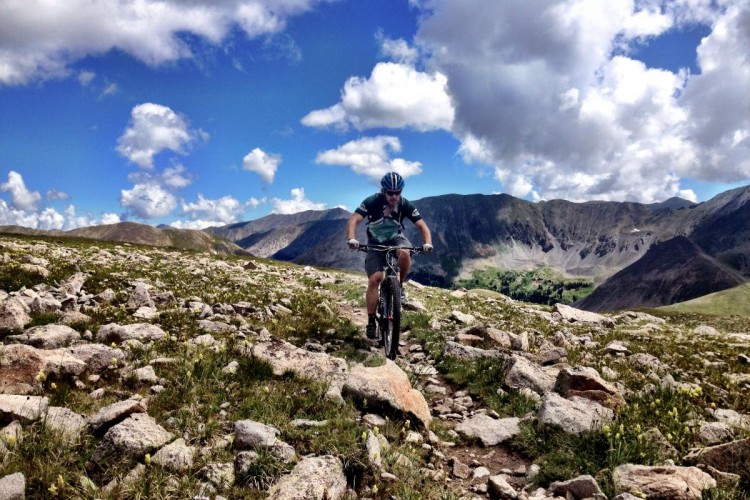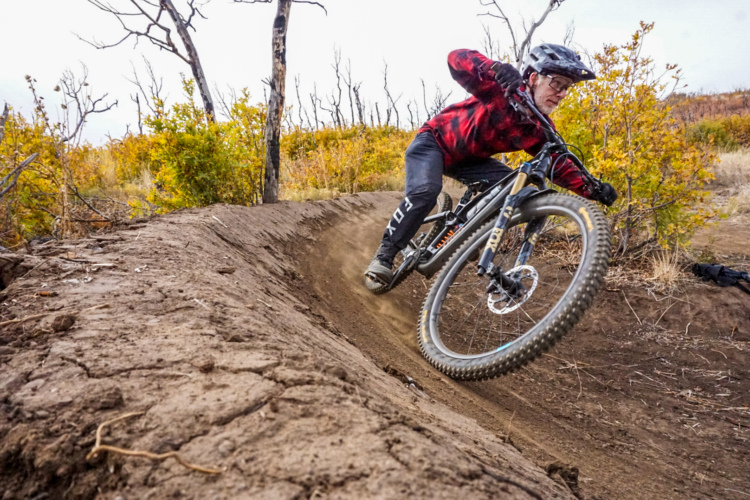
Confession time: when I was en-route to Europe for a three-week tour of as many of the best mountain bike trails as I could fit in, I considered my first week-long stop in the Pyrenees mountain range, which forms the border between France and Spain (with Andorra sandwiched in between) a preview, an appetizer to the main course: riding in the world-famous Alps.
But on my long, long flight back to the States, exhausted, physically destroyed, and thoroughly enamored with the mountain biking in Europe, as I reflected on the parts of my trip that I enjoyed the most, I realized that objectively, the very best mountain biking that I experienced during my time in Europe wasn’t found in the Alps like I thought it would be—it was in the Pyrenees.
Now don’t get me wrong, I had an absolutely superb time riding in the Alps, and one of the trails I rode in Switzerland was probably the single best ride of the entire trip. But for most people, when I tell them that the riding in the Pyrenees was, overall, way better than the mountain biking I experienced in the Alps, I can tell they don’t really believe me.
Heck, even compared to the Rockies, the Pyrenees absolutely rock! Seriously, I was blown away by this mountain range—a true sleeper, under-the-radar mountain bike destination.
Here are 7 reasons why the Pyrenees deserve to rank among the raddest mountain bike destinations in the world:
1. The Cultural Immersion Is Unparalleled

Compared to other parts of Europe that I’ve visited, the cultural immersion in the Spanish Pyrenees is second-to-none. Part of this incredible cultural experience is thanks to the fact that Spain isn’t truly a first world country, like its nearby neighbor France. Instead, especially in the rural areas like the Pyrenees, development seems to be a massive step behind the rest of the developed world. This feeling of stepping back 20 (or more) years in time is largely due to the influence of Francisco Franco’s long 36-year dictatorship, which ended in 1975. During this time, the rest of the first world raced ahead in technological and social developments and Spain was left behind in a big way.
One crucial example of this is the rail system. Franco decreed that Spain would use a different rail gauge from the rest of Europe, in an attempt to prevent invasion during World War II. While the Second World War never made it to Spain, that unique rail gauge has persisted to this day, so if you want to take a train from Spain to the rest of Europe, you’re forced to switch trains at the border. Not only are the trains different, but many of the trains are old and run-down, with at least one breakdown expected on every train trip from the Pyrenees to the bustling city of Barcelona.

The lack of spoken English also contributes to the feeling of immense cultural immersion. Unlike much of northern Europe, when you travel into the rural areas of Spain, don’t expect to be able to navigate on spoken and written English alone. It’s rare to find signs and menus in English, and when it comes to waiters or other staff, their English may be broken at best.
So, to make my way around when I wasn’t with my guide, Jordi Bonet of MTB Dreams, I tried to rely on my own broken Spanish, thanks to years of Spanish classes in high school and college. However, I found that as I listened to conversations I was often unable to understand anything, and the words on many signs were unfamiliar. This is because the majority of our trip was spent in a region of Spain called Catalunya. Think of Catalunya like a state in the United States, but one that has its own distinct culture, and its own spoken and written language—Catalan. This is why I could rarely understand what anyone was saying, because they weren’t speaking Spanish at all—they were speaking Catalan.
Catalan isn’t even a variant or dialect of Spanish—it is absolutely its own unique language. However, thankfully, everyone in Catalunya still speaks Spanish, meaning you can navigate on spoken Spanish. But if you’re coming from the States, expect even the Spanish to be difficult due to the dialectical and vocabulary differences from that of Latin America and South America, which we are most accustomed to.

While we spent the majority of our time on the Spanish side of the border, for one day of our trip we drove over to the French side of the border for a double-header two-ride day in France. While it’s still very much the Pyrenees, both the language and the culture change at the border; “hola” on the trail is exchanged for “bon jour.” So if cultural experience is your main goal, you can easily experience three distinct countries in the Pyrenees, if you include Andorra.
2. The Quality of the Singletrack Is Exceptional

While culture is great and everything, the quality of the singletrack is the most important factor that makes or breaks a destination, now isn’t it? While I can’t fully explain in this short space the incredible scope of the singletrack riding available in the Pyrenees—check out my article from yesterday titled “5 Epic MTB Descents in the Spanish Pyrenees You Need to Ride Before You Die” for more on this point—in short, the trails were stunning and absolutely impressive! Steep and technical, slow speed and demanding in spots, high speed and flowing in others, with every kind of natural terrain imaginable from above-treeline alpine tracks to endless rock gardens, switchbacks, roots and forested sections, wet sections, and even slickrock–the variety was unfathomable.

Many times we’d drop 3,000-4,000 feet in one descent, never knowing what we’d encounter around the next corner, constantly surprised by the ever-changing terrain.
In comparison to some rides in other parts of Europe, the ratio of singletrack to dirt roads was very high, and the ratio of top-quality trail to low-quality also was very favorable. On some rides in the Alps we pedaled a lot of dirt roads for relatively little singletrack, but in the Pyrenees, especially with van uplifts to the top, the riding was overwhelmingly high-quality singletrack!
3. A Low Number of Mountain Bikers, and Very Little Mountain Biking Infrastructure

While some may take a lack of mountain biking infrastructure and the relatively low number of mountain bikers to be a negative, I think it can be seen as a positive value as well. Simply put, rarely encountering riders on the trail (granted, we were riding in the shoulder season) made it feel like we had vast mountain expanses all to ourselves, enhancing the feeling of exploration and adventure.
While MTB Dreams took great care of me, when we encountered mechanical difficulties like a lost derailleur jockey wheel, we had to cannibalize one of Jordi’s friends’ bikes for a spare, as there wasn’t an adequately-stocked bike shop in that particular area.
More than a reason for the quality of the destination, I consider the relative lack of riders in the Pyrenees, especially in some regions like Vall Fosca, to be an indicator of how undervalued and under-the-radar this region truly is as a mountain bike destination. While some parts of the Alps may get thousands more riders, in many instances I think this is because these destinations are more easily accessible from larger, more affluent population centers and are better documented in travel literature.
4. The Mountains Are Steep, and the Valleys Are Narrow

While the Alps are also stupid-steep, the steepness of the Pyrenees also overshadows that of the Rockies, on average. Many of the trails we rode were steep plunges down the sharp-angled mountain sides, ending in the valleys far, far below.


All of the valleys that we stayed in and finished our rides in were extremely narrow, with impressive mountain ridges rising straight up from the rivers and water bodies, forming a formidable ring of rock around the small amount of habitable land. Toward the end of our journey we stayed in La Cerdanya, which my guide Jordi told me was the widest valley in the Pyrenees—and it didn’t even appear to be as far across as my home Arkansas Valley, not to mention other much wider and expansive valleys in the Rockies like the San Luis Valley.
The narrowness of the valleys and the drastic change in elevation drive home how hardy you have to be to excel as an athlete in the Pyrenees–especially if you don’t have a shuttle for every ride like we did. Kilian Jornet is arguably the best ultrarunner in the world in 2016, as well as one of the very best skimo athletes on the planet. While he now lives in Norway, he was born and raised in the Cerdanya region of the Pyrenees, and the bar where we finished the final ride of our trip was decorated with Kilian photos and memorabilia.
5. The History Is More Accurately Preserved and Easily-Accessible

Of course this is related to #1 above, but similar to the cultural immersion, the lengthy history of human civilization in the Pyrenees is much more in force and accessible on a daily basis. Instead of all of the ancient buildings that are still standing being relegated to tourist attractions and museums, the people of Spain actually use their historic buildings as everyday housing, bed and breakfasts, businesses, and restaurants.



In Bellver de Cerdanya I stayed in the old town, lodging in a bed and breakfast on the ancient town square in a building that was hundreds of years old—and still looked it. In the Alps, it seemed like many mountain towns featured a classic alpine wood construction, which precludes the age of enormous stone buildings like those found in the ancient villages sprinkled across the Pyrenees. Rolling into a town halfway through your ride and checking out a thousand-year-old church is an incredible experience that everyone needs to have!

6. Roads to the Top of Every Trail


While having roads spidering all through the mountains is a negative as it pertains to the wilderness character of an area, if you aren’t interested in climbing over a vertical mile every single day, having a road to the top of all of the epic singletrack descents is an incredible boon! While you won’t find daily, scheduled shuttles up to the tops of these trails (see #3 above), if you connect with an accomplished local guide like Jordi from MTB Dreams, he can organize all the shuttles you could ever desire! Every single one of our 11 rides featured a van uplift, providing a truly unique enduro mountain biking experience.

Do you actually prefer to grind up thousands of feet of uber-steep mountain every single day? That’s great, and you can do that too (MTB Dreams can make any trip you can imagine a reality), but more often than not you’ll just be grinding away on the same well-graded gravel roads that we rode up in our van.
7. So Many Different Valleys and Zones to Explore!

I still don’t think I’ve fully wrapped my head around the sheer volume of singletrack available in the Pyrenees. As Jordi and I looked out over La Cerdanya from the 500-year-old battlements of Bellver, he told me that while we had seen six valleys over the course of five days, that normally he would only visit one valley with a client, and they would spend a full week of riding in just one of these six valleys without experiencing all the singletrack that that valley has to offer. Just in La Cerdanya, Jordi’s home, it would take weeks to explore all the mountain bike trails available! While we cherry-picked the very best singletrack that the area had to offer, there is so, so much more we didn’t get to explore—a true lifetime of mountain biking adventures.
I guess I’ll just have to go back!
Thanks to MTB Dreams for making this trip possible!











7 Comments
Feb 27, 2018
I have a Cube 120 Stereo and thought of bike packing around, then staying in an area to do some loops before moving on to somewhere else. Time, fortunately, is not a restriction.
Are there any resources you can point me to?
Cheers :)
Dec 7, 2016
. . . but now I seem to be developing a new problem: Travel Envy!
Dec 11, 2016
Dec 11, 2016
Dec 11, 2016
Dec 11, 2016
Dec 11, 2016